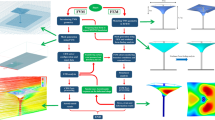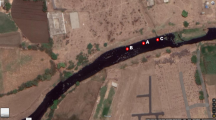Abstract
In order to reduce the cost of oceanographic exploration, a new underwater vehicle is designed to sail the required distance with the lowest energy consumed. Since the new underwater vehicle is a complicated multidisciplinary system, it is firstly decomposed into four smaller disciplines and then a multidisciplinary design optimization (MDO) problem is built based on these disciplines. The Multidisciplinary Feasible (MDF) architecture is adopted as the solution strategy to this optimization problem considering that it is easily implemented and a multidisciplinary feasible solution is always guaranteed throughout the optimization process. To solve this optimization problem efficiently, the coupled adjoint method is firstly introduced to improve the efficiency of gradient calculation and then a discipline-merging method is proposed to further enhance the computational efficiency. After this, the discipline-merging method is verified against the finite difference method in two aspects of solution accuracy and computational costs and the results show it is an effective and high efficient gradient calculation method. Finally, the multidisciplinary design optimization of the new underwater vehicle is performed efficiently under the MDF architecture with the discipline-merging method to calculate gradients.


















Similar content being viewed by others
References
Alam K, Ray T, Anavatti SG (2014) A brief taxonomy of autonomous underwater vehicle design literature. Ocean Eng 88(Complete):627–630
Alexandrov NM, Lewis RM (2002) Analytical and computational aspects of collaborative optimization for multidisciplinary design. AIAA J 40(2):301–309
Balling R, Sobieszczanski-Sobieski J (1996) Optimization of coupled systems: A critical overview of approaches. AIAA J 34(1):6– 17
Blidberg DR, Turner RM, Chappell SG (1991) Special issue intelligent autonomous systems autonomous underwater vehicles: Current activities and research opportunities. Robot Auton Syst 7(2):139–150
Bloebaum C, Hajela P, Sobieszczanski-Sobieski J (1992) Non-hierarchic system decomposition in structural optimization. Eng Optim 19(3):171–186
Bovio E, Cecchi D, Baralli F (2006) Autonomous underwater vehicles for scientific and naval operations. Ann Rev Control 30(2):117–130
Braun RD (1996) Collaborative optimization: An architecture for large-scale distributed design (Unpublished doctoral dissertation)
Braun RD, Gage PJ, Kroo IM, Sobieski IP (1996) Implementation and performance issues in collaborative optimization. In: Proceedings of the 6th aiaa/usaf/nasa/issmo multidisciplinary analysis and optimization symposium. Bellevue, WA. (AIAA 1996- 4017)
Brown NF, Olds JR (2006) Evaluation of multidisciplinary optimization techniques applied to a reusable launch vehicle. J Spacecr Rocket 43(6):1289–1300
Cramer EJ, Dennis JE, Frank PD, Lewis RM, Shubin GR (1994) Problem formulation for multidisciplinary optimization. SIAM J Optim 4(4):754–776
Du X, Pan G, Song B, Hu H, Li J (2007) Simulation of long-distance auv in low speed maneuvers. J Syst Simul 19(3):470–477
Granville (1969) Geometrical characteristics of streamlined shapes. Defense Technical Information Center
Haftka RT (1985) Simultaneous analysis and design. AIAA J 23(7)
Haftka RT, Watson LT (2005) Multidisciplinary design optimization with quasiseparable subsystems. Optim Eng 6:9–20
Hulme K, Bloebaum C (2000) A simulation-based comparison of multidisciplinary design optimization solution strategies using cascade. Struct Multidiscip Optim 19:17–35
Jones E, Oliphant T, Peterson P et al (2015) SciPy: Open source scientific tools for Python
Kodiyalam S (1998) Evaluation of methods for multidisciplinary design optimization (MDO), phase 1 (NASA Report No. CR-1998-208716)
Kodiyalam S, Yuan C (2000) Evaluation of methods for multidisciplinary design optimization (MDO), part 2 (NASA Report No. CR-2000-210313)
Kroo IM (1997) MDO for large-scale design. In: Alexandrov NM, Hussaini MY (eds) Multidisciplinary design optimization: State-of-the-art. SIAM, pp 22–44
Martins JRRA, Hwang JT (2013a) Review and unification of methods for computing derivatives of multidisciplinary computational models. AIAA J 51(11):2582–2599
Martins JRRA, Lambe AB (2013) Multidisciplinary design optimization: A survey of architectures. AIAA J 51(9):2049–2075. doi:10.2514/1.J051895
Parsons J, Goodson R, Goldschmied F (1974) Shaping of axisymmetric bodies for minimum drag in incompressible flow. J Hydronaut 8(3):100–107
Perez RE, Jansen PW, Martins JRRA (2012) pyOpt: a Python-based objectoriented framework for nonlinear constrained optimization. Struct Multidiscip Optim 45(1):101–118
Renaud JE, Gabriele GA (1994) Approximation in nonhierarchic system optimization. AIAA J 32(1):198–205
Sobieszczanski-Sobieski J (2008) Integrated system-of-systems synthesis. AIAA J 46(5):1072–1080
Sobieszczanski-Sobieski J, Agte JS, Sandusky R (2000) Bilevel integrated system synthesis. AIAA J 38 (1):164–172
Sobieszczanski-Sobieski J, Altus TD, Phillips M, Sandusky R (2003) Bilevel integrated system synthesis for concurrent and distributed processing. AIAA J 41(10):1996–2003
Song B, Zhu Q, Liu Z (2010) Research on multi-objective optimization design of the uuv shape based on numerical simulation. In: Advances in swarm intelligence: First international conference, part i (pp. 628–635). Springer Berlin Heidelberg, Berlin, Heidelberg
Tedford NP, Martins JRRA (2010) Benchmarking multidisciplinary design optimization algorithms. Optim Eng 11(1):159–183
Wang P, Song B, Wang Y, Zhang L (2007) Application of concurrent subspace design to shape design of autonomous underwater vehicle, vol 03. IEEE Computer Society, DC, USA
Wynn RB, Huvenne VA, Bas TPL, Murton BJ, Connelly DP, Bett BJ, Hunt JE (2014) Autonomous underwater vehicles (auvs): Their past, present and future contributions to the advancement of marine geoscience. Mar Geol 352:451–468. 50th Anniversary Special Issue
Yi SI, Shin JK, Park GJ (2008) Comparison of mdo methods with mathematical examples. Struct Multidiscip Optim 35(5):391–402
Acknowledgments
This research was supported by the National Natural Science Foundation of China under Grant No. 51375389.
Author information
Authors and Affiliations
Corresponding author
Appendices
Appendix A: Earth-fixed and Body-fixed reference frames
In order to analyze the motion of the new underwater vehicle, two reference frames are introduced in this paper: earth-fixed reference frame O 0 x 0 y 0 z 0 and body-fixed reference frame O x y z, which are shown in Fig. 19. The earth-fixed reference frame is used to represent the motion of the new underwater vehicle relative to the ground. The axes of O 0 x 0 y 0 z 0 are fixed with the ground. Generally, the origin O 0 is chosen at the launch point on the ground, the axis O 0 x 0 points to the launch direction, the axis O 0 y 0 is vertically upwards and the axis O 0 z 0 is determined by right-hand rule. The body-fixed reference frame are used to describe the velocity and acceleration of the new underwater vehicle. Its origin O is usually set at the center of buoyancy. The axis O x is the longitudinal axis directed from the after to the forward end of the body, the axis O y is the normal axis directed from top to bottom and the axis O z is the transverse axis directed to starboard.
In order to measure the center of buoyancy, we introduce the front tip reference frame whose axes are parallel to the body-fixed reference frame but with the origin at the front tip point X 0, which are shown in Fig. 20.
Appendix B: Motion state parameters
The motion of the new underwater vehicle with respect to the earth-fixed reference frame can be represented by the motion of body-fixed reference frame relative to the earth-fixed reference frame.
The new underwater vehicle has six DOF which can be determined by the vectors (x 0,y 0,z 0) and (𝜃,ψ,ϕ), respectively. The vector (x 0,y 0,z 0) represents the coordinate point of the origin of body-fixed reference frame in earth-fixed reference frame and the vector (𝜃,ψ,ϕ) describes the angular orientation of the body-fixed reference frame relative to the earth-fixed reference frame. Specifically, ψ is defined as the angle between the projection of O x on the plane x 0 O 0 z 0 and the axis O 0 x 0, which is positive when the head of the new underwater vehicle is at the left of O 0 x 0. ϕ is defined as the angle between the axis O y and the vertical plane which is through O x and perpendicular to the plane x 0 O 0 z 0, which is positive when the axis O y is at the right of the vertical plane observed from the after to the forward of the new underwater vehicle.
The vector (v x ,v y ,v z ) denotes the linear velocity of the center of buoyancy of the new underwater vehicle projected to the body-fixed reference frame. The vector (w x ,w y ,w z ) denotes the angular velocity of body-fixed reference frame projected to the body-fixed reference frame.
α and β respectively represent the angle of attack and the angle of side slip of the new underwater vehicle as shown in Fig. 21. α is the angle between the projection of velocity (v x ,v y ,v z ) on the plane x O y and the axis O x, which is positive when the velocity is below the head of the new underwater vehicle. β is the angle between the velocity and the plane x O y, which is positive when the velocity is at the right of the head of the new underwater vehicle.
Rights and permissions
About this article
Cite this article
Zhang, D., Song, B., Wang, P. et al. Multidisciplinary optimization design of a new underwater vehicle with highly efficient gradient calculation. Struct Multidisc Optim 55, 1483–1502 (2017). https://doi.org/10.1007/s00158-016-1575-2
Received:
Revised:
Accepted:
Published:
Issue Date:
DOI: https://doi.org/10.1007/s00158-016-1575-2







